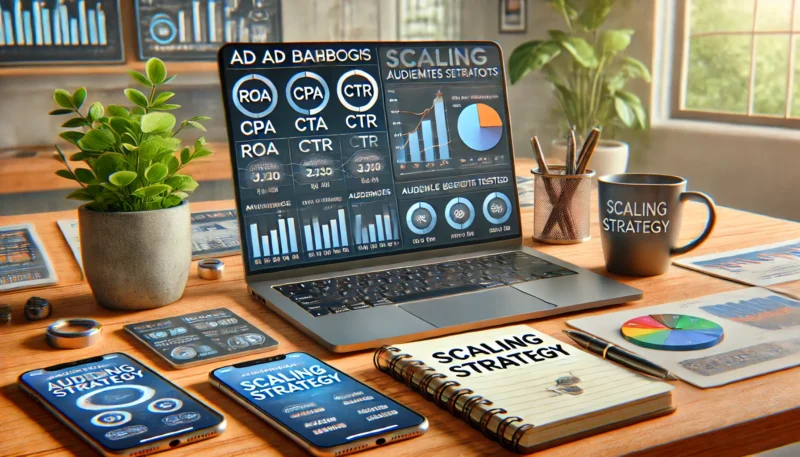You launched your ad campaigns, tested your creatives, optimized your funnel — and now it’s working. Great! But how do you scale up without killing your ROAS?
Scaling paid ads is not just about spending more. If done carelessly, increasing your ad budget can actually decrease performance and burn profit.
In this guide, you’ll learn how to scale your paid ads strategically and sustainably, across platforms like Facebook, Google, and TikTok — without losing the efficiency that got you there in the first place.
What Does Scaling Mean in Paid Ads?
Scaling means increasing your ad spend while maintaining (or improving) your key metrics like:
-
ROAS (Return on Ad Spend)
-
CPA (Cost per Acquisition)
-
CTR (Click-through Rate)
-
CVR (Conversion Rate)
There are two main ways to scale:
1. Vertical Scaling: Increasing budget on existing ad sets or campaigns
2. Horizontal Scaling: Expanding to new audiences, creatives, or platforms
Why Scaling Can Kill Your ROAS (If Done Wrong)
Here’s what usually happens when people scale too fast:
-
Ad costs spike due to audience saturation
-
Campaigns exit the learning phase too quickly
-
Lower-quality impressions reduce conversion rates
-
Budget increases disrupt optimization signals
-
Retargeting audiences dry up faster
To avoid this, scale with structure, testing, and control.
Vertical Scaling: How to Increase Ad Spend Smartly
1. Follow the 20–30% Rule
Increase your budget by no more than 20–30% per day on a working ad set. Bigger jumps can reset the learning phase (especially on Meta).
✅ If you’re spending $100/day, test $120–$130 the next day.
2. Duplicate Winning Ad Sets
Instead of editing a high-performing ad set, duplicate it with a higher budget. This preserves the original performance and creates a new test.
✅ Tip: Let both versions run and compare ROAS after 3–5 days.
3. Use Campaign Budget Optimization (CBO)
Let the algorithm distribute budget across ad sets based on performance.
✅ CBO works best when you have multiple strong ad sets and a budget of $100+/day.
Horizontal Scaling: Reach New Audiences and Angles
1. Expand to Lookalike Audiences
Use high-quality source data like:
-
Purchasers
-
Repeat buyers
-
High LTV customers
Then build lookalikes (1%–3%) in Facebook or Google Similar Audiences.
2. Launch New Creatives and Offers
Even your best ad will fatigue. Add variety by testing:
-
New hooks
-
Different formats (video, UGC, carousels)
-
New CTAs
-
Limited-time offers or bundles
✅ Run creative testing in parallel with scaling budgets.
3. Test New Geographic Markets
If you’re converting well in one country or region, expand to similar markets.
✅ Adjust ad copy, currencies, and cultural elements to fit the new location.
4. Retarget with New Messaging
As you drive more traffic, your retargeting audience grows. Create fresh retargeting ads based on:
-
What they viewed
-
What they abandoned
-
Time since last interaction
✅ Use urgency or scarcity to re-engage warm leads.
Scaling on Google Ads: Smart Techniques
-
Use broad match with smart bidding for scalable search
-
Expand keyword themes instead of individual keywords
-
Add Performance Max campaigns for broader reach
-
Layer in remarketing lists and in-market audiences
Scaling on Facebook/Instagram: Smart Techniques
-
Use Advantage+ Shopping Campaigns (if eCommerce)
-
Expand interest-based audiences
-
Stack lookalikes with broad targeting
-
Use automated rules to increase budget based on CPA or ROAS thresholds
Key Metrics to Watch While Scaling
-
ROAS (must stay above break-even)
-
CPA (should stay stable or decrease)
-
CTR and CVR (signal ad health)
-
Frequency (avoid going above 3–4 for cold audiences)
-
Blended return (total profit, not just platform ROAS)
✅ Always watch overall business profit, not just platform dashboards.
When to Pause or Pull Back
Scaling isn’t forever. Watch for warning signs like:
-
ROAS drop >30%
-
Spike in CPC or CPM
-
Ad fatigue in creative (drop in CTR)
-
Diminishing returns even with higher spend
✅ Scale back, regroup, optimize — then scale again with fresh data.
Final Thoughts: Scale With Control, Not Emotion
The goal of scaling isn’t to spend more — it’s to earn more efficiently.
-
Increase budget incrementally
-
Expand what’s working, not what’s easy
-
Watch your metrics daily
-
Be patient — scaling takes structure and testing
When done right, you turn a working campaign into a profitable growth machine.

